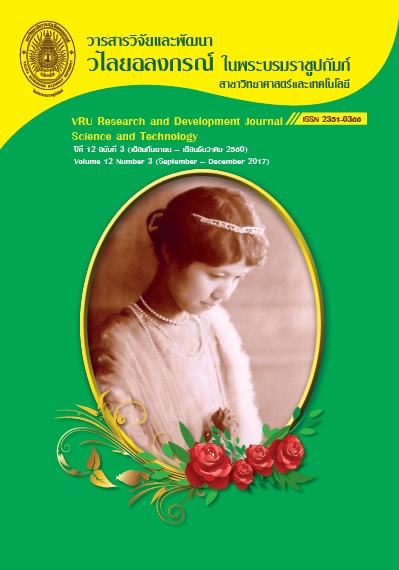การเปลี่ยนแปลงคุณภาพของปลาส้มในระหว่างการหมักร่วมกับโพรไบโอติก Lactobacillus casei 01 ที่ระดับแตกต่างกัน
Main Article Content
Abstract
งานวิจัยนี้ได้ทำการศึกษาคุณลักษณะของผลิตภัณฑ์ปลาส้มที่ผ่านการหมักร่วมกับโพรไบโอติก Lactobacillus casei 01 ที่ระดับต่าง ๆ (2, 4, 6 และ 8 เปอร์เซ็นต์ โดยปริมาตรต่อน้ำหนัก) เปรียบเทียบกับปลาส้มที่หมักด้วยเชื้อตามธรรมชาติ (ชุดควบคุม) โดยวิเคราะห์คุณภาพทางด้านกายภาพ ด้านเคมี ด้านจุลชีววิทยา และการยอมรับของผู้บริโภค จากผลการทดลองพบว่า เมื่อบ่มที่อุณหภูมิ 37 องศาเซลเซียส เป็นระยะเวลา 3 วัน ค่าสี L* (ค่าความสว่าง) และ b* (ค่าความเป็นสีเหลือง) ของตัวอย่างทุกชุดการทดลองมีแนวโน้มที่เพิ่มขึ้น ส่วนค่าสี a* (ค่าความเป็นสีแดง) มีค่าลดลง โดยที่ปลาส้มที่หมักร่วมกับ L. casei 01 ที่ปริมาณ 8 เปอร์เซ็นต์ มีค่าสี L* สูงกว่าตัวอย่างอื่นอย่างมีนัยสำคัญทางสถิติ ในขณะที่ค่าสี a* มีค่าต่ำที่สุด ส่วนค่าสี b* มีค่าที่ไม่แตกต่างกันอย่างมีนัยสำคัญทางสถิติ นอกจากนั้นยังพบว่าปลาส้มที่หมักร่วมกับ L. casei 01 ปริมาณ 8 เปอร์เซ็นต์ มีค่าความเป็นกรด-ด่าง (pH) ต่ำที่สุด ซึ่งสอดคล้องกับการเพิ่มขึ้นของปริมาณกรดทั้งหมด เมื่อพิจารณาปริมาณสารไบโอเจนิคเอมีนในตัวอย่างปลาส้ม พบว่า ปลาส้มที่หมักร่วมกับ L. casei 01 มีปริมาณสารไบโอเจนิคเอมีนทุกชนิดต่ำกว่าปลาส้มที่หมักด้วยเชื้อตามธรรมชาติ โดยเฉพาะอย่างยิ่งปลาส้มที่หมักร่วมกับ L. casei 01 ที่ปริมาณ 6 และ 8 เปอร์เซ็นต์ นอกจากนั้นยังพบว่า ตัวอย่างปลาส้มที่หมักร่วมกับ L. casei 01 ทุกระดับมีคุณภาพด้านจุลชีววิทยาเป็นไปตามมาตรฐานผลิตภัณฑ์ชุมชนสำหรับปลาส้ม (มผช. 26/2557) จากการทดสอบทางประสาทสัมผัสของปลาส้มดิบและปลาส้มทอด พบว่า คะแนนความชอบในแต่ละคุณลักษณะของตัวอย่างทุกชุดการทดลองอยู่ในช่วง 7 ถึง 8 คะแนน และปลาส้มที่หมักร่วมกับ L. casei 01 ที่ปริมาณ 2-6 เปอร์เซ็นต์ ได้การคะแนนการยอมรับสูงที่สุด ดังนั้นการหมักปลาส้มร่วมกับ L. casei 01 ที่ปริมาณ 6 เปอร์เซ็นต์ จึงเป็นระดับที่เหมาะสมที่สุด เนื่องจากผลิตภัณฑ์ที่ได้มีความปลอดภัย และได้รับการยอมรับจากผู้บริโภค
This research was to study the characteristics of Plaa-som products as fermented with probiotic Lactobacillus casei 01 at different levels (2%, 4%, 6% and 8%, v/w) and compared to conventional fermented Plaa-som (control). Physicochemical, microbiological and consumer acceptance of the products were investigated. Results showed that, during incubation at 37ºC for 3 days, the L* (brightness) and b* (yellowish) values of all samples were trended to increase, while the reduction of a* (redness) values was observed. Plaa-som inoculated with 8% L. casei 01 found to have the significant higher in the L* and lesser in the a* than other samples, whereas the b* displayed insignificance. The lowest pH was found in Plaa-som inoculated with 8% L. casei 01, which was accorded with the increase of total acidity. Considering the biogenic amines, all Plaa-som inoculated with L. casei 01 contained biogenic amines lower than the conventional fermented Plaa-som, in particular Plaa-som inoculated with 6% and 8% L. casei 01. In addition, the microbiological qualities of the samples that inoculated with L. casei 01 were complied with the limits of the Thai Community Product Standard for Plaa-som (TCPS No. 26/2014). For sensory evaluation, the liking scores of all uncooked and fried samples’ attributes were ranged from 7 to 8 points. Plaa-som inoculated with 2-6% L. casei 01 showed higher in acceptance scores. Therefore, the optimal level of L. casei 01 for Plaa-som production was 6%, since the final product was harmless and accepted by consumers.
Downloads
Article Details
Copyright Notice
The copyright of research articles published in the VRU Research and Development Journal Science and Technology Journal belongs to the Research and Development Institute, Valaya Alongkorn Rajabhat University under the Royal Patronage. Reproduction of the content, in whole or in part, is prohibited without prior written permission from the university.
Responsibility
The content published in the VRU Research and Development Journal Science and Technology Journal is the sole responsibility of the author(s). The journal does not assume responsibility for errors arising from the printing process.
References
ณัฐกฤตา ภู่ทับทิม และวนิดา แซ่จึง. 2559. การคัดเลือกแบคทีเรียแลคติกและใช้เป็นต้นเชื้อบริสุทธิ์ในการหมักปลาส้ม. วารสารวิทยาศาสตร์และเทคโนโลยี. 24(6)(ฉบับพิเศษ) : 952-967.
ทิพย์กมล ภูมิพันธ์ อุไรวรรณ อินทร์ม่วง. 2559. สุขลักษณะของการประกอบกิจการผลิตปลาร้าและปลาส้ม ในอำเภอหนึ่ง จังหวัดขอนแก่น, วารสารวิจัย มข. (ฉบับบัณฑิตศึกษา). 16(2) : 75-85.
ปรมาภรณ์ เจ็ดวรรณะ คมแข พิลาสมบัติ รุจริน ลิ้มศุภวานิช อดิศร เสวตวิวัฒน์ และ จุฑารัตน์ เศรษฐกุล. 2554. การศึกษาคุณภาพและจุลินทรีย์ของแหนมเนื้อโคโดยใช้เชื้อ Lactococcus lactis subsp. lactis P 2 และ Sb 2 เป็นกล้าเชื้อในการหมักแหนม. วารสารเกษตรพระจอมเกล้า. 29(3) : 46-54.
ปิ่นมณี ขวัญเมือง. (2546). แบคทีเรียกรดแลคติกในผลิตภัณฑ์อาหารหมักดอง. วารสารครุศาสตร์อุตสาหกรรม. 3(1) : 62-69.
วงศ์ทิพา โรจนประภพ. 2551. ฮีสตามีน (histamine) สารที่ทำให้เกิดอาการแพ้เมื่อรับประทานอาหารทะเล. สำนักพัฒนาศักยภาพนักวิทยาศาสตร์ห้องปฏิบัติการ กรมวิทยาศาสตร์บริการ.
สิรินดา ยุ่นฉลาด สุกานดา วิชิตพันธุ์ งามนิจ นนทโส และพิกุลทอง ขอเพิ่มทรัพย์. 2548. การเปลี่ยนแปลงประชากรจุลินทรีย์ และทางเคมีระหว่ากระบวนการหมักปลาส้มที่เป็นผลิตภัณฑ์ปลาหมักของไทย. วารสารงานวิจัย มข. 10(3) : 188-198.
สุทธวัฒน์ เบญจกุล. 2549. ซูริมิ วิทยาศาสตร์และเทคโนโลยีเนื้อปลาบด. พิมพ์ครั้งที่ 1. กรุงเทพฯ : สำนักพิมพ์โอเดียนสโตร์.
Abdulmumeen, H. A., Risikat, A. N. and Sururah, A. R. (2012). Food: Its preservatives, additives and applications. International Journal of Chemical Sciences. 1: 36-47.
AOAC. (2000). Official Methods of Analysis of AOAC International (17th ed.). Gaithersburg, Maryland, USA: AOAC International.
Chaikham, P. (2015). Stability of probiotics encapsulated with Thai herbal extracts in fruit juices and yoghurt during refrigerated storage Food Bioscience. 12: 61–66
Jittrepotch, N., Rojsuntornkitti, K. and Kongbangkerd, T. (2015). Physico-chemical and sensory properties of Plaa-som, a Thai fermented fish product prepared by using low sodium chloride substitutes. International Food Research Journal. 22(2): 721-730.
Kalac, P., Spicka, J., Krizek, M. and Pelikanova, T. (2000). The effect of lactic acid bacteria inoculants on biogenic amines formation in sauerkraut. Food Chemistry. 70: 355-359.
Kongkiattikajorn, J. 2015. Potential of starter culture to reduce biogenic amines accumulation in som-fug, a Thai traditional fermented fish sausage. Journal of Ethnic Foods. 2: 186-194.
Leroy, F. and De Vuyst, L. (2004). Lactic acid bacteria as functional starter cultures for the food fermentation industry. Trends in Food Science and Technology. 15: 67-78.
Nanasombat, S., Phunpruch, S. and Jaichalad, T. (2012). Screening and identification of lactic acid bacteria from raw seafoods and Thai fermented seafood products for their potential use as starter cultures. Songklanakarin Journal of Science and Technology. 34(3): 255-262.
Onsurathum, S., Pinlaor, P., Haonon, O., Chaidee, A., Charoensuk, L., Intuyod, K., Boonmars, T., Laummaunwai, P. and Pinlaor, S. (2016). Effects of fermentation time and low temperature during the production process of Thai pickled fish (pla-som) on the viability and infectivity of Opisthorchis viverrini metacercariae. International Journal of Food Microbiology. 218: 1–5.
Rezaei, M., Jafari, H., Sahari, M. A., Hosseini, H., Montazeri, N., Parviz M. and Nazarinia, A. (2007). Relation of biogenic amines and bacterial changes in ice-stored southern caspian kutum (Rutilus frisiikutum). Journal of Food Biochemistry. 31(4): 541–550.
Riebroy, S., Benjakul, S., Visessanguan, W., Kijrongrojana, K. and Tanaka, M. (2004). Some characteristics of commercial Som-fug produced in Thailand. Food Chemistry. 88: 527-535.
Sanders, M. E., Guarner, F., Guerrant, R., Holt, P. R., Quigley, E. M., Sartor, R. B., Sherman, P. M. and Mayer, E. A. (2013). An update on the use and investigation of probiotics in health and disease. Gut. 62(5): 787–796.
Tanikawa, E. (1985). Marine products in Japan (2nd ed.). Tokyo, Japan: Kaseisha-Kasukaku Co.
US Food and Drug Administration. (2001). Bacteriological Analytical Manual (BAM). Washington DC, USA: New Hampshire Avenue, Department of Health and Human Services.
Visessanguan, W., Benjakul, S., Riebroy, S. and Thepkasikul, P. (2004). Changes in composition and functional properties of proteins and their contributions to Nham characteristics. Meat Science. 66: 579-588.


